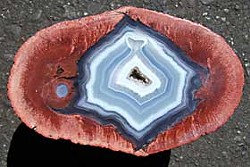[
{
"name": "Top Stories Video Pair",
"insertPoint": "7",
"component": "17087298",
"parentWrapperClass": "fdn-ads-inline-content-block",
"requiredCountToDisplay": "1"
}
]
Wave-polished translucent agates, as in the bottom photo, are found on Agate Beach and northward by eager collectors who brave the hazards of being swept out to sea by rogue waves. Agates consist of microscopically crystallized silica (silicon dioxide), called "chalcedony." They often show growth bands. They originate in the hellish conditions of volcanic eruptions, followed by millenia of gentle soaking in warm groundwaters. These "geothermal" waters slowly precipitated the chalcedony in cavities produced by volcanic steam.
The rock in the above photo is called a "thunder-egg." It is hosting two distinct agate-filled cavities, one small and round, the other large and jagged. To understand this five-inch specimen, imagine red hot lava spilling from the throat of a volcano. Lava consists of oxides of silicon, aluminum, calcium and other elements. And lava invariably contains a few percent dissolved water (which sometimes escapes violently, producing steam explosions).
The small round object in this specimen was a bubble of steam in the lava. Lavas with high silica contents have difficulty crystallizing into minerals upon cooling, and end up as non-crystalline obsidian glass. In our specimen, however, the steam bubble acted as a seed that initiated the growth of tiny crystals within the hot glass, which then proceeded to crystallize radially outward to produce a roughly spherical shell, called a "spherulite," centered on the bubble. The concentration of dissolved water in the hot residual glass between the tiny crystals increased to the point of breaking open the spherulite, in order to release more steam. This steam created a large, jagged cavity near the bubble.
The rock containing our spherulite with two cavities cooled and was buried by subsequent volcanic eruptions. Everything was then soaked for millenia in geothermal waters typical of volcanic environments. Hot water can dissolve traces of silica, and as that water percolated up through cracks it cooled and precipitated layers of silica-chalcedony, namely agate, in any cavities it encountered, such as our original steam bubble and jagged steam cavity. (As an aside, the small remaining hole in the center of our jagged agate is lined with quartz crystals, so this thunder-egg meets the definition of a "geode.")
How the agates were freed from from their host rocks, transported by rivers, broken and abraded, and finally polished on our beaches, is another story.
Happy hunting!
Don Garlick is a geology professor retired from HSU. He invites any questions relating to North Coast science, and if he cannot answer it he will find an expert who can. E-mail [email protected]. The agates pictured were collected by Mike and Cece Novak.
Speaking of Science
-

HSU Expanding Curriculum with Polytechnic Push
Jun 15, 2021 -

Davos Won't Save Us
Jan 23, 2020 -

The Need to Study Weed
Jan 16, 2020 - More »
Comments (3)
Showing 1-3 of 3
more from the author
-
Nuclear Matters
- May 6, 2010
-
Sophie Smells a Shaker
- Feb 4, 2010
-
The Roots of Love
- Feb 5, 2009
- More »
































